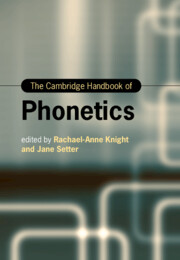Book contents
- The Cambridge Handbook of Phonetics
- Cambridge Handbooks in Language and Linguistics
- The Cambridge Handbook of Phonetics
- Copyright page
- Contents
- Figures
- Tables
- Contributors
- Introduction
- Section I Segmental Production
- Section II Prosodic Production
- Section III Measuring Speech
- Section IV Audition and Perception
- Section V Applications of Phonetics
- 20 Pedagogical Approaches
- 21 Pronunciation Teaching
- 22 Sociophonetics
- 23 Developmental Phonetics of Speech Production
- 24 Clinical Phonetics
- 25 Forensic Phonetics
- 26 The Phonetics of Talk in Interaction
- 27 The Phonetics/Phonology Interface
- Index
- References
24 - Clinical Phonetics
from Section V - Applications of Phonetics
Published online by Cambridge University Press: 11 November 2021
- The Cambridge Handbook of Phonetics
- Cambridge Handbooks in Language and Linguistics
- The Cambridge Handbook of Phonetics
- Copyright page
- Contents
- Figures
- Tables
- Contributors
- Introduction
- Section I Segmental Production
- Section II Prosodic Production
- Section III Measuring Speech
- Section IV Audition and Perception
- Section V Applications of Phonetics
- 20 Pedagogical Approaches
- 21 Pronunciation Teaching
- 22 Sociophonetics
- 23 Developmental Phonetics of Speech Production
- 24 Clinical Phonetics
- 25 Forensic Phonetics
- 26 The Phonetics of Talk in Interaction
- 27 The Phonetics/Phonology Interface
- Index
- References
Summary
This chapter addresses the bidirectional interface between phonetics and speech-language therapy/pathology, focusing on the application of phonetic principles and methods within the clinical domain. The history of clinical phonetics as a phonetic subdomain is charted, including the birth of the extensions to the IPA for disordered speech (extIPA). Three critical issues are touched on: the complexities of the phonetics/phonology interface in discussing disordered speech; the related clinical application of different levels of transcription; and how advancing technologies are enabling clinical phoneticians to better understand the implications of clinical conditions for speech perception and production. In discussing a range of clinical populations and affected speech subsystems, it highlights some of the salient phonetic features explored in recent years and insights gained from different instrumental methods. Best practice for teaching and learning is described in the context of the professional training objective of most clinical phonetics programmes, and future directions of clinical phonetics are hypothesised in terms of the evolving technological and clinical landscapes.
Keywords
- Type
- Chapter
- Information
- The Cambridge Handbook of Phonetics , pp. 603 - 630Publisher: Cambridge University PressPrint publication year: 2021

